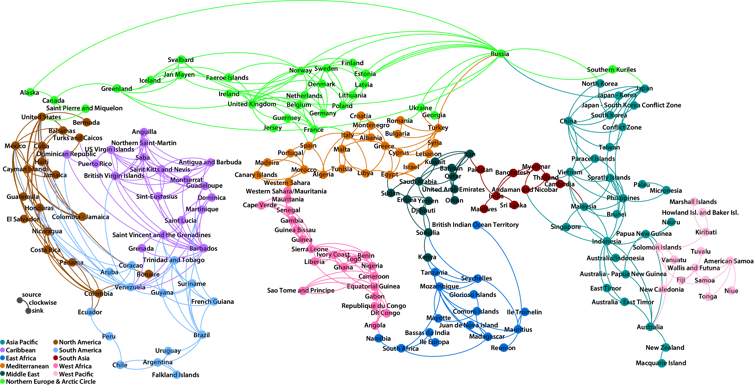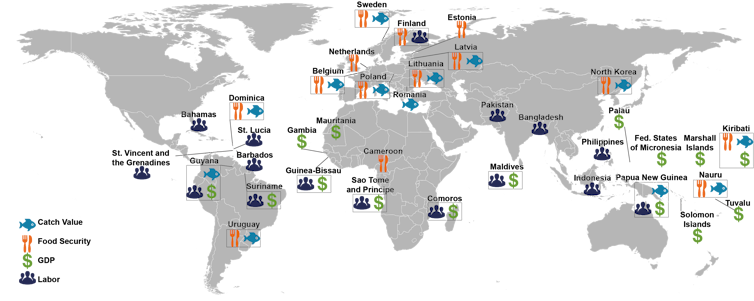Fish larvae float across national borders, binding the world's oceans in a single network
- Written by Nandini Ramesh, Postdoctoral Researcher in Earth and Planetary Science, University of California, Berkeley
Fish populations are declining[1] around the world, and many countries are trying to conserve them by regulating their fishing industries. However, controlling fishing locally may not do enough to strengthen fish populations. Often one nation’s fish stocks depend on the spawning grounds of a neighboring country, where fish release eggs and sperm into the water and larvae hatch from fertilized eggs.
We do research on oceans[2], climate[3] and fisheries[4]. In a recent study, we showed that global fisheries are even more tightly connected[5] than previously understood. The world’s coastal marine fisheries form a single network, thanks to the drift of larvae along ocean currents.
This suggests that country-by-country fishery management may be fundamentally insufficient. If a fish species that provides food to one country should decline, the amount of fish spawn, or eggs and larvae, riding the ocean currents from there to other countries would also decline dramatically, resulting in further loss of fish elsewhere.
Many countries live with this risk, although they may not realize it. To manage fisheries effectively, nations must understand where the fish in their territories originate.
 Ocean currents affect the speed at which fish eggs and larvae drift and vary through the year. This map shows surface current speeds for January: yellow = fastest, dark blue = slowest. Each country’s territory is highlighted with red dots during the month of maximum spawning activity in that country. In each territory, a different number of species spawn in each month of the year. The red dots appear in the month during which the largest number of species spawn in that territory.
Ocean currents affect the speed at which fish eggs and larvae drift and vary through the year. This map shows surface current speeds for January: yellow = fastest, dark blue = slowest. Each country’s territory is highlighted with red dots during the month of maximum spawning activity in that country. In each territory, a different number of species spawn in each month of the year. The red dots appear in the month during which the largest number of species spawn in that territory.Crossing national borders
Fish don’t recognize political boundaries, and regularly travel internationally. Scientists have tracked adult fish movements[6] using electronic tags, and have shown that a few species migrate over long distances[7].
Countries and territories have negotiated agreements to ensure sustainable sharing of migratory fish. One such agreement joins several nations in the Western and Central Pacific Fisheries Commission to ensure that the territories fish cross share them sustainably[8].
But fish eggs and larvae are much harder to follow. Many species lay eggs in large numbers that float near the ocean surface. When they hatch, larvae measure a few millimeters long and continue to drift as plankton until they grow large enough to swim. During these stages of the life cycle, ocean currents sweep fish spawn across international boundaries.
Simulating the journeys of eggs and larvae
Like weather on land, the pattern of ocean currents varies with the seasons and can be predicted. These currents are typically sluggish, traveling about an inch per second, or less than 0.1 miles per hour.
There are a few exceptions: Currents along the eastern coasts of continents, like the Gulf Stream in North America or the Kuroshio in Asia, and along the equator can be significantly faster, reaching speeds of 2 miles per hour. Even a gentle current of 0.1 miles per hour can carry spawn 40 miles over a month, and some species can float for several months.
Government and academic scientists use a vast network of satellites[9], moored instruments[10] and floating buoys[11] to monitor these surface flows. Using this information, we performed a computer simulation of where drifting particles would be carried over time. Scientists have used this type of simulation[12] to study the spread of marine plastic pollution[13] and predict where debris from plane crashes at sea[14] could have washed ashore.
Different fish species spawn in different seasons, and a single species may spawn in several months at different locations. We matched the seasons and locations of spawning for over 700 species[15] with ocean current data[16], and simulated where their spawn would drift. Then, using records[17] of where those species have been fished, and information about how suitable conditions are for each species[18] in different regions, we deduced what fraction of the fish caught in each country arrived from other countries because of ocean currents.
A small-world network
Scientists and policymakers can learn a lot by studying these international connections. Each species that floats across international boundaries during its plankton stage represents a linkage between countries. These linkages span the world in a dense, interconnected network.
 Each color represents a region in the network of fish larvae connections. This map shows the strongest 467 connections among a total of 2,059 that the authors modeled.
Nandini Ramesh, James Rising and Kimberly Oremus, CC BY-ND[19]
Each color represents a region in the network of fish larvae connections. This map shows the strongest 467 connections among a total of 2,059 that the authors modeled.
Nandini Ramesh, James Rising and Kimberly Oremus, CC BY-ND[19]
At a global level, this network of connections has an important property: It is a small-world network[20]. Small-world networks connect regions that are far apart to each other by just a few steps along the network. The concept is rooted in social scientist Stanley Milgram’s 1960s experiments with social networks[21], which found that it was possible for a letter to reach almost any total stranger by passing through six or fewer hands. Milgram’s work was popularized in the 1990 play “Six Degrees of Separation[22].”
Among fisheries, the world seems even smaller: We found that the average number of degrees of separation among fisheries is five. This means that local problems can become global risks.
For example, imagine that a fishery collapses in the middle of the Mediterranean. If the population in one spawning region collapses, it could quickly put pressure on neighboring fisheries dependent upon it. If fishers in those neighboring countries overfish the remaining population or shift to other species, the disturbance can grow. Within just a few years, a fisheries disturbance could travel around the world.
We assessed how countries would be affected in terms of food security, employment and gross domestic product if they were to lose access to fish spawn from other territories. The most affected countries cluster in the Caribbean, the western Pacific, Northern Europe and West Africa. These hotspots correspond to the network’s most clustered areas, because the effects of these flows of fish spawn are most pronounced where many coastal countries lie in close proximity.
 International flows of fish eggs and larvae affect countries’ total catch, food security, jobs and economies.
Nandini Ramesh, James Rising and Kimberly Oremus, CC BY-ND[23]
International flows of fish eggs and larvae affect countries’ total catch, food security, jobs and economies.
Nandini Ramesh, James Rising and Kimberly Oremus, CC BY-ND[23]
Thinking globally about fisheries
Because the world’s fisheries are so interconnected, only international cooperation that takes flows of fish spawn into account can effectively manage them. Aside from egg and larvae connections, fisheries are linked by movements of adult fish and through agreements among countries allowing them to fish in each other’s waters.
All of this suggests that fishery management is best conducted at a large, international scale. Proposals for doing this include defining Large Marine Ecosystems[24] to be jointly managed and creating networks of Marine Protected Areas[25] that safeguard a variety of critical habitats. Ideas like these, and careful study of interdependence between national fisheries, are crucial to sustainable use of the oceans’ living resources.
[ Expertise in your inbox. Sign up for The Conversation’s newsletter and get a digest of academic takes on today’s news, every day.[26] ]
References
- ^ Fish populations are declining (www.worldwildlife.org)
- ^ oceans (scholar.google.com)
- ^ climate (scholar.google.com)
- ^ fisheries (scholar.google.com)
- ^ more tightly connected (dx.doi.org)
- ^ tracked adult fish movements (doi.org)
- ^ migrate over long distances (ocean.si.edu)
- ^ share them sustainably (www.fao.org)
- ^ satellites (www.nesdis.noaa.gov)
- ^ moored instruments (climatedataguide.ucar.edu)
- ^ floating buoys (www.argo.ucsd.edu)
- ^ type of simulation (doi.org)
- ^ marine plastic pollution (plasticadrift.org)
- ^ debris from plane crashes at sea (www.nytimes.com)
- ^ over 700 species (www.fishbase.se)
- ^ ocean current data (www.atmos.umd.edu)
- ^ records (www.seaaroundus.org)
- ^ how suitable conditions are for each species (www.aquamaps.org)
- ^ CC BY-ND (creativecommons.org)
- ^ small-world network (doi.org)
- ^ 1960s experiments with social networks (www.thecut.com)
- ^ Six Degrees of Separation (www.dramatists.com)
- ^ CC BY-ND (creativecommons.org)
- ^ Large Marine Ecosystems (www.lmehub.net)
- ^ networks of Marine Protected Areas (cmsdata.iucn.org)
- ^ Expertise in your inbox. Sign up for The Conversation’s newsletter and get a digest of academic takes on today’s news, every day. (theconversation.com)
Authors: Nandini Ramesh, Postdoctoral Researcher in Earth and Planetary Science, University of California, Berkeley

